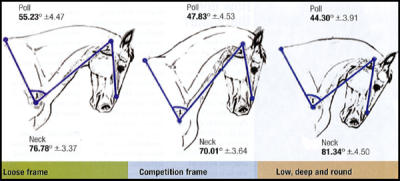 Three European universities designed a study* to evaluate the stress level of horses relative to head and neck position. In the study, the researchers measured cortisol (the hormone related to stress levels found in saliva), the horses’ heart rate, their heart beat intervals, and behavioral signs such as head tossing.
Three European universities designed a study* to evaluate the stress level of horses relative to head and neck position. In the study, the researchers measured cortisol (the hormone related to stress levels found in saliva), the horses’ heart rate, their heart beat intervals, and behavioral signs such as head tossing.
15 Medium to Grand Prix level dressage horses were used in the study. Each rode a predetermined 10-minute test by their traditional rider at three different head carriages:
- Loose Frame: Reigns were kept as loose as possible and the rider did not try to obtain a specific head set.
- Competition Frame: The bridge of the nose was vertical and neck at a 70.01 degree angle (+ or – 3.6 degrees)
- Low Deep and Round: The bridge of the nose was behind the vertical and the chin was close to touching the chest.
Each of these horses was worked on a regular bases at the “low, deep, and round” position so this newest of the exercise would not induce increased stress levels.
The study found that horses riding at the low, deep and round position had “significantly higher cortisol concentration immediately after being ridden.” Additionally, stress behaviors like head movement or shaking were seen in this position. Heart rate and heart beat intervals were unchanged.
Learn More About Decreasing a Horse’s Stress Levels by Contacting Mid Rivers Equine Centre Today.
Call (800) 828-4517
*Reference: “How Head Carriage Affects Stress Levels” Equus June 2014